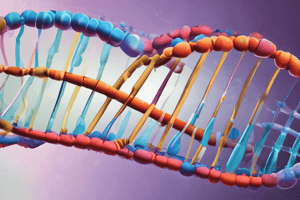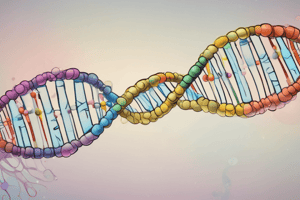Podcast
Questions and Answers
During DNA replication, which enzyme is responsible for unwinding the double helix structure by breaking the hydrogen bonds between base pairs?
During DNA replication, which enzyme is responsible for unwinding the double helix structure by breaking the hydrogen bonds between base pairs?
- DNA Polymerase
- Primase
- Helicase (correct)
- Ligase
In the context of DNA structure, what is the significance of the term 'antiparallel'?
In the context of DNA structure, what is the significance of the term 'antiparallel'?
- It signifies that the nitrogenous bases are oriented in the same direction on both strands to facilitate proper base pairing.
- It refers to the identical sequence of nucleotides on both DNA strands.
- It indicates that the two DNA strands run in opposite directions, with one strand running 5' to 3' and the other 3' to 5'. (correct)
- It describes the parallel arrangement of phosphate groups and deoxyribose sugars.
What is the primary function of DNA ligase in DNA replication?
What is the primary function of DNA ligase in DNA replication?
- To add complementary nucleotides to the template strand.
- To seal gaps between Okazaki fragments on the lagging strand. (correct)
- To initiate the synthesis of RNA primers.
- To unwind the double helix structure.
Why is maintaining high genetic diversity important for a species?
Why is maintaining high genetic diversity important for a species?
Which of the following best explains the universality of the genetic code?
Which of the following best explains the universality of the genetic code?
What is the role of the start codon AUG in protein synthesis?
What is the role of the start codon AUG in protein synthesis?
According to the central dogma of molecular biology, what is the correct sequence of information flow in a cell?
According to the central dogma of molecular biology, what is the correct sequence of information flow in a cell?
During transcription, what type of RNA molecule carries the genetic information from the DNA in the nucleus to the ribosomes in the cytoplasm?
During transcription, what type of RNA molecule carries the genetic information from the DNA in the nucleus to the ribosomes in the cytoplasm?
What is the primary function of tRNA (transfer RNA) in translation?
What is the primary function of tRNA (transfer RNA) in translation?
Which of the following characteristics of DNA contributes to its stability for accurately passing on genetic information?
Which of the following characteristics of DNA contributes to its stability for accurately passing on genetic information?
Flashcards
What is DNA?
What is DNA?
Deoxyribonucleic acid, a molecule present in the nucleus of cells, containing genetic instructions for all known living organisms.
What is a nucleotide?
What is a nucleotide?
A subunit of DNA consisting of a deoxyribose sugar, a phosphate group, and an organic base.
What is DNA replication?
What is DNA replication?
The process of creating an exact copy of DNA, ensuring genetic information is passed on.
What is Helicase?
What is Helicase?
Signup and view all the flashcards
What is DNA Polymerase?
What is DNA Polymerase?
Signup and view all the flashcards
What is Ligase?
What is Ligase?
Signup and view all the flashcards
What are mutations?
What are mutations?
Signup and view all the flashcards
What is the universality of the genetic code?
What is the universality of the genetic code?
Signup and view all the flashcards
What are Stop Codons?
What are Stop Codons?
Signup and view all the flashcards
What is a Start Codon?
What is a Start Codon?
Signup and view all the flashcards
Study Notes
- DNA, or deoxyribonucleic acid, is a chemical substance present in the nucleus of all cells in all living organisms.
- It is a large molecule composed of a long chain of subunits called nucleotides.
- Each nucleotide contains a deoxyribose sugar, a phosphate group (-PO4), and an organic base.
- The phosphate group is located on the 5' end, while deoxyribose is on the 3' end.
- DNA is antiparallel to ensure the proper connection of guanine, cytosine, adenine, and thymine nitrogenous bases.
Replication
- DNA replication is the process of creating an exact copy of DNA to ensure genetic continuity.
- Helicase unwinds the double helix by breaking hydrogen bonds.
- DNA Polymerase adds complementary nucleotides.
- Ligase seals gaps to form two identical DNA strands.
Mutation and Variation
- Mutations are changes in DNA sequences that generate genetic variation, which drives evolution and diversity.
- High genetic diversity enables species to adapt to environmental changes and avoid inbreeding.
- Inbreeding, common in small, isolated populations, can reduce a species' ability to survive and reproduce.
Universality of Genetic Code
- The genetic code is universal, with all living organisms using the same DNA code to build proteins.
- Stop codons include UAA, UAG, and UGA.
- The start codon is AUG.
Stability and Adaptability
- DNA's helix structure protects genetic information and ensures both stability for genetic inheritance and adaptability for evolution.
- Base nucleotides include guanine, cytosine, adenine, and thymine (GCAT).
Central Dogma
- The central dogma of molecular biology involves DNA transcription and translation to synthesize proteins that direct the function of an organism.
- Transcription converts DNA to RNA.
- Translation converts RNA to amino acids.
- mRNA (messenger RNA), tRNA (transfer RNA), and rRNA (ribosomal RNA) are types of RNA.
Studying That Suits You
Use AI to generate personalized quizzes and flashcards to suit your learning preferences.




